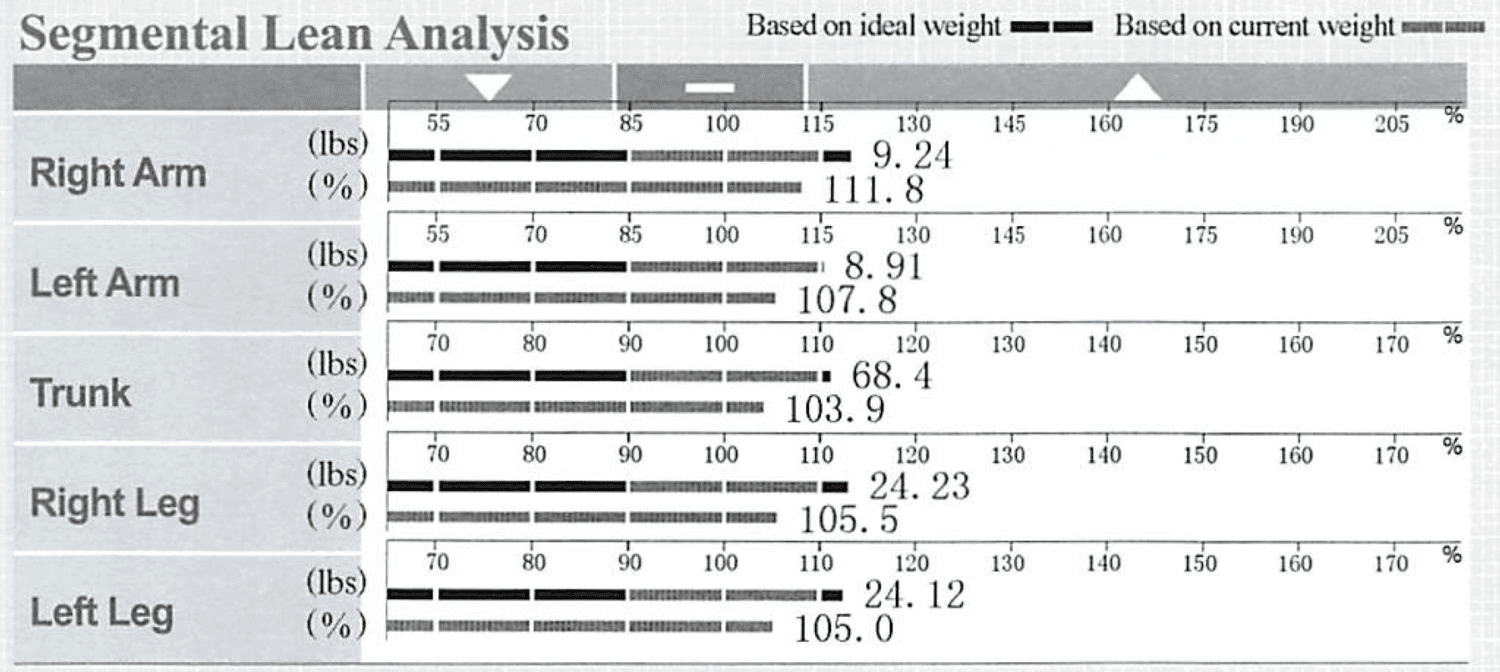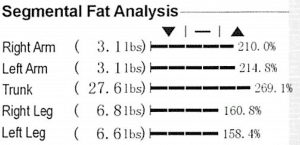The scale alone is not the best way to measure your weight loss progress.
This week’s healthcast is a continuation of a discussion we began in our last Healthcast. We are discussing the knowledge and information we can obtain by using some modern technology to measure the various compositional components of your body. These devices are in our offices and are free for your use as patients. We like them because they allow us to track your progress and measure exactly where you need to focus on your journey to good health and strong bodies.
Once you have replaced your lost testosterone you will be better able to do aerobic and resistance exercise, as well as diet, in your journey to good health. In particular this week we will discuss the various body types that can be identified and the specific information that provides us with and the treatment program we suggest in order to get you back into shape.
Muscle-Fat Analysis

Compares an individual with healthy amounts of muscle and fat for your weight and height. It also tells the doctor where you store your fat, and if you need more T or more exercise.
- NL Skeletal muscle measures what you consider muscle—not your heart or smooth muscle in your intestines.
- The normal range is calculated against your weight and height. Being high is fine, but having a low number means:
-Add more meat cheese and eggs, or amino acids to your life
-Exercise with weights specifically the limbs or trunk that has a low amount of muscle mass
When we look at this graph we step back and look at the shape the three graphs make:

- Type C – Low muscle mass = Weak, old, or with low T.
- Type I – Average body type = normal weight, muscle mass, and fat.
- Type D – High muscle mass = Normal weight and strong.
OVERVIEW OF THE BODY TYPES/ AND TYPES OF TREATMENT:
- Type D – More muscle than fat:
Keep up the good work. As you age there is a tendency to gain belly fat so follow your body composition and make changes in diet/exercise when necessary.
- Type C – More fat than muscle and high body weight:
This type takes a lot of work! You must lose weight and fat, and preserve and build your muscle mass with high protein diet and resistance training (not just aerobic exercise).
-Cut out sugar, cabs, and alcohol. You need to get healthy!
-Get Testosterone Pellets
- Normal weight/Lots of muscle/very little body fat = Athletic Body Type I
This is a healthy body type but make sure you don’t lose too much fat. It is stored for times when we are sick.
- Normal weight and normal Body Fat/low muscle mass = Weak Type C
You are the couch potato who looks thin and survives on chips and wine so get up, move, and work out! You got here by lack of exercise, a low protein diet, or an increased metabolism that eats up your muscle. Symptoms include swelling, poor muscle mass with hanging skin, trouble thinking, infections, and loss of energy.
- Very high fat and weight/normal muscle= Dangerous Obesity (Obese C Type)
Hurry up and go on a strict diet with lots of aerobic exercise. You are at risk for a heart attack, heart failure, diabetes, high BP, breast and colon cancer, high BP and prostate cancer.
- Above average weight/above average muscle/ low body fat: Athletic Body type
Your weight might go up but it means you are making more muscle, not fat!
- High everything: Chronic Obesity
Do not take pride in the fact that you have a high level of muscle because that is just your body developing muscle to get you around, and support your high weight. You need to lose fat and weight, so cut back on carbs and calories.
- Low everything—Weak and Health Complications
Poor nutrition, lack of exercise, and starving. This is what I see with those people who are anorexic and don’t move because they are so weak. BTW – these folks think they look good!
- Type I Body with Normal Everything—Ideal body type
Keep up the good work!

This section of the test shows a comparison of BMI, discussed above, and Percent Body Type. Percent Body Fat is obtained by the InBody Machine and tells us the percentage of your weight in body fat. This tells a doctor more information about your health because it is a more accurate measurement than just weigh vs height which is the BMI.
The normal for % body fat for men is less than 19%. The % body fat for women is less than 26%.
 After measuring your lean body mass which is the total amount of muscle and bone that your body contains, we then measure the number of pounds of muscle that you have in each limb and your trunk. This is a great way to see how your exercise has worked and which areas you need to improve on. If you have a higher than average amount of muscle in your arms, that is ok. It is less healthy to have insufficient amount of muscle in any of your body areas because that is associated with aging without testosterone and it’s also associated with poor health.
After measuring your lean body mass which is the total amount of muscle and bone that your body contains, we then measure the number of pounds of muscle that you have in each limb and your trunk. This is a great way to see how your exercise has worked and which areas you need to improve on. If you have a higher than average amount of muscle in your arms, that is ok. It is less healthy to have insufficient amount of muscle in any of your body areas because that is associated with aging without testosterone and it’s also associated with poor health.

The segmental fat analysis is similar to the Segmental Lean Analysis, except that it reveals the number of pounds of fat that you have in your limbs and torso. This can help assist your doctor in advising you to change your exercise program, or it may help you decide on esthetic fat removal, such as iLipo, or Liposuction.
Basal Metabolic Rate
The number of calories you burn a day determines whether you will gain or lose weight on the amount of food you eat. For example, if you have a basal metabolic rate of 1885 calories, that means if you lie in bed and sleep for 24 hours that is the number of calories you will consume doing nothing. If you exercise and burn another 1000 calories that day, and you eat 2,885 calories then you won’t gain or lose any weight.
If you are aware of your BMR you can lose weight if you exercise more and burn more calories than your BMI + your food intake. Less food, more exercise causes you to lose fat!

Belly Fat= Visceral Fat is the worst fat you can have for your health. We have found that the more belly fat a person has the higher is their risk for heart disease, stroke, diabetes, hypertension, and cancer. This fat is inside your abdominal wall and sits like a yellow apron in front of your intestines. The thicker it is, the more you look distended at the belt line. We measure this fat because of the danger it places you in. In this graph if you are at or below 10 you are safe, and if it is over 10 then you are in danger. This type of fat indicates that you need to increase your aerobic exercise, and decrease carbohydrates in your diet. Sometimes we prescribe Metformin to assist in the loss of this fat.
Summary
Now you can review your results and your progress. Each time a patient steps on the machine and enters his or her code, that patient’s progress is plotted on the graph at the bottom of the printout. This type of evaluation can be useful for weight-loss programs, determining whether a person needs testosterone replacement, and following a patient’s progress with diet and exercise programs. We use it daily to plan Testosterone Pellet treatment, follow up progress after treatment, and to reassure patients that they are making progress.
This Health cast was written and presented by Dr. Kathy Maupin, M.D., Bio-identical Hormone Replacement Expert and Author, with Brett Newcomb, MA., LPC., Family Counselor, Presenter and Author. www.BioBalanceHealth.com.



